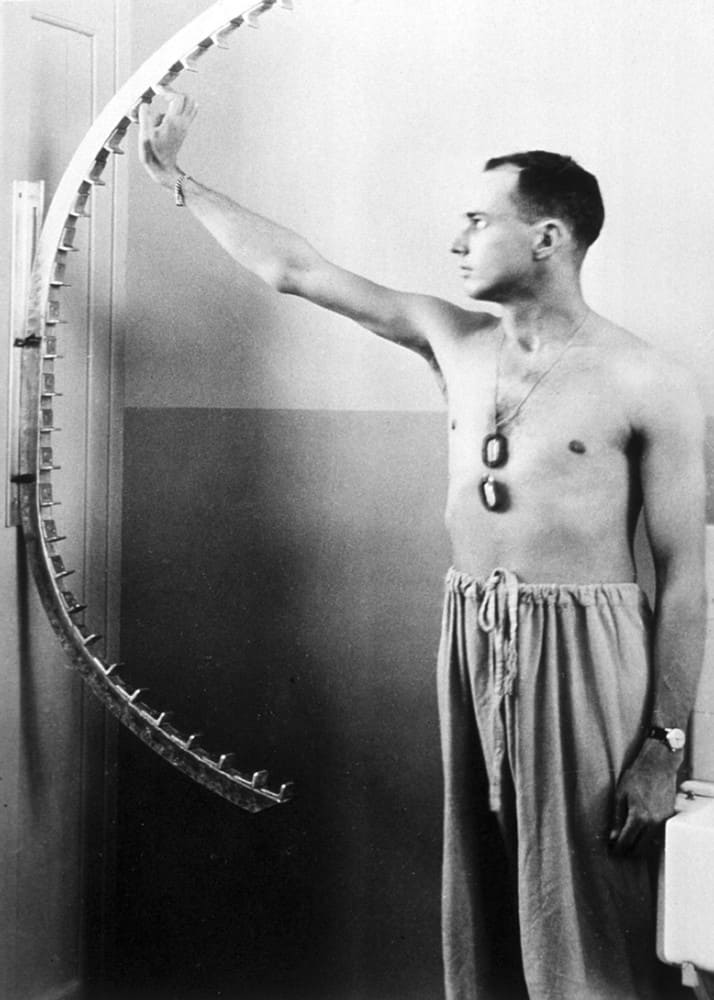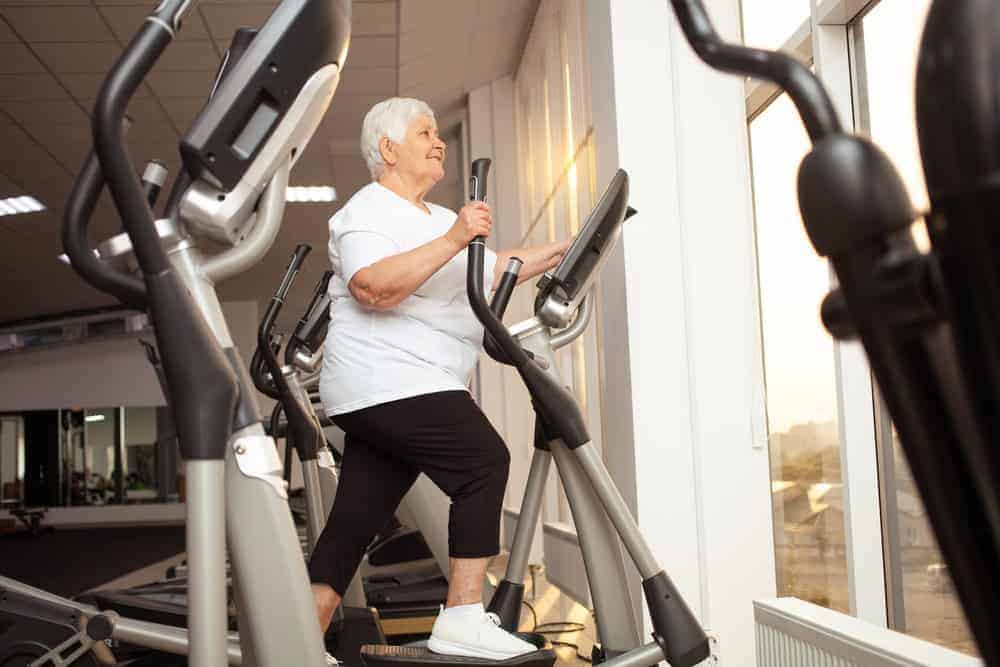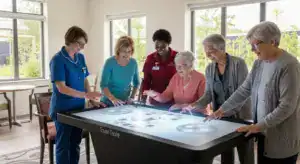The beginning of physical therapy in the United States dates back to World War I when injured soldiers needed rehabilitation to recover from their injuries. Mary Mcmillan, a wartime nurse and one of the first physical therapists, then called reconstruction aides, played a crucial role in helping soldiers regain strength and mobility through exercise and massage.
After the war, the profession grew as doctors and hospitals recognized the benefits of physical therapy (PT) for patients recovering from surgery, illness, or injury. In 1921, the first professional organization for physical therapists, known as the American Women’s Physical Therapeutic Association (AWPTA), was founded.

[physical therapy patient sometime in the middle of the twentieth century]
Over the years, the field of physiotherapy expanded to include various specialties, such as sports therapy and geriatric care. Physical therapists (PTs) help people of all ages improve their health and quality of life through targeted exercises and treatments.
Today, PT continues to be an essential part of healthcare, providing personalized care to help patients recover from injuries, manage chronic conditions, and maintain their overall well-being.
It has a vital role in the recuperation process for many seniors, who often suffer from stiff joints and muscle pain, are prone to falls, or need to regain their mobility after a period of bed rest.
Timeline for Physical Therapy
If you or your beloved senior have been prescribed physical therapy, you may wonder what you should expect. The duration of your treatment plan may vastly differ and last anywhere from a month to three or years. The timeline for a physical therapy program varies based on individual needs, so consider the list below as a general guideline.
Your First Visit
The therapist will review your medical history and assess your current condition. They will create a personalized treatment plan tailored to your needs.
First Few Weeks (Weeks 1-2)
The initial goal is to reduce pain and improve mobility. You’ll be guided through gentle exercises and receive advice on how to move better and more safely.
Middle Weeks (Weeks 3-6)
As you begin to feel better, you should expect the exercises to become slightly more challenging. Your therapist will want you to build strength and flexibility. You will also work on improving balance and coordination.
Later Weeks (Weeks 7-12)
With progress, the focus of your therapy will shift to becoming even more robust and capable of performing everyday activities and your hobbies. The exercises will be more intensive and functional.
Ongoing Care (Weeks 13 and beyond)
Once you reach your physiotherapeutic goals, you will transition to a maintenance program. This includes regular exercises and occasional check-ins with the therapist to ensure you continue improving and maintaining your progress.

[therapist correcting older woman’s posture during balance exercises]
Naturally, the exact timeline of your therapy will depend on the severity of your condition and how quickly you progress. Your therapist will regularly assess your progress and adjust the plan as needed to support your optimal recovery.
What to Expect At Your First Appointment
The first session is vital for setting a baseline and devising a clear strategy for your recovery. During your first physical therapy appointment, you can expect the following:
- Initial Assessment
The therapist will go over your medical history with you, enquiring about any past injuries, surgeries, and current medications. They will ask about your symptoms, pain levels, and how your condition affects your daily activities.
- Physical Exam
You will undergo a physical examination during which your therapist will assess your strength, flexibility, balance, posture, and range of motion. They may ask you to perform specific movements to understand your limitations and pain points better.
- Discussion of Goals
You’ll talk about your goals for the physical therapy, whether it’s pain relief, improved mobility, increased strength, or recovering abilities to perform specific activities. This helps the therapist tailor the treatment plan to your needs.
- Development of Treatment Plan
Based on the assessment, the therapist will create a personalized treatment plan. This plan will outline the types of exercises and therapies you will undergo, the frequency of your sessions, and the expected timeline for your recovery.
- Introduction to Exercises
The next step will be for the therapist to guide you through some initial exercises and techniques that you’ll be using in future sessions. They will explain the purpose of each exercise and how it will help you achieve your goals.
- Education and Advice
You’ll receive advice on managing your condition at home, including tips on posture, movements to avoid, and how to perform daily activities safely. The therapist may also provide instructions for exercises you can do on your own to complement your therapy sessions.
- Questions and Answers
You will have the opportunity to ask any questions you have about your condition, the treatment plan, and what to expect in future sessions.
- Scheduling
At the end of the appointment, you’ll plan your upcoming sessions based on the therapist’s recommendations and your availability.
The first appointment is crucial for establishing the starting point and creating a clear plan for your therapy. It sets the stage for a collaborative effort between you and your therapist to achieve your recovery goals.
The First Few Weeks
The goals for the first few weeks of physical therapy are generally attempting to accomplish the following:
- Manage your pain. Your therapist will focus on reducing any pain and discomfort you may be feeling. This could involve gentle exercises, manual therapy, such as massage or joint mobilization, and modalities such as heat, ice, ultrasound, or electrical stimulation. The methods chosen should facilitate movement without exacerbating your condition.
- Improve mobility. Initial exercises will be directed to improve your range of motion and flexibility. These exercises are often low-intensity and designed to ease you into movement without causing further pain.

[physical therapist showing elderly couple very light exercises]
- Teach you how to go about your day safely. Your therapist will teach you proper body mechanics and techniques to perform daily activities without causing yourself further injuries. This includes advice on posture, lifting, and other movements tailored to your specific needs.
- Enquire about your homework. You’ll be asked if at home you have completed the set of exercises tailored to your specific needs and designed to complement the in-clinic treatments.
- Monitor and make adjustments. The therapist will closely monitor your progress, noting any changes in pain levels, mobility, and overall function. Based on how your body responds, they will adjust your treatment plan as needed.
- Build strength and stability. As you progress, the therapist will introduce exercises that target muscle strengthening and stability. These exercises will progressively become more challenging but are essential for long-term improvement.
- Improve balance and coordination. Exercises to improve balance and coordination will be added to your routine to help you move more confidently and reduce the risk of falls.
- Feedback and encouragement. Your therapist will provide regular feedback on your progress, offering encouragement and tips to help you stay motivated.
- Communication. Open communication with your therapist is encouraged. You should feel free to discuss any concerns, pain, or difficulties you are experiencing.

[physical therapist working with an older woman on building strength]
The first few weeks are when you work on laying the foundation of your recovery. The emphasis is on reducing pain, improving mobility, and setting up an exercise routine that is sustainable for you and will support your long-term goals.
What Happens During the Middle and Later Weeks of Physical Therapy
Middle Weeks (Weeks 3-6)
As you begin to feel better and stronger, your physical therapist will introduce more challenging exercises. These exercises are designed to build more strength and flexibility in your muscles and joints.
You will also continue to do exercises to improve your balance and coordination, which will help you move with more confidence and safety. In this phase, your therapist works with you until you are both sure you can handle daily activities without pain or discomfort.
Later Weeks (Weeks 7-12)
During this period, the focus shifts to getting you even stronger and more capable of doing everyday tasks and hobbies you enjoy. Your exercises will become more strenuous to ensure you will soon be able to return to your normal routine.
This might include lifting heavier weights, doing more complex movements, or working on your endurance. The goal is to help you reach a point where you feel strong, flexible, and confident in your abilities.
Throughout these weeks, your physical therapist will keep an eye on your progress. They will adjust your exercises as needed to make sure you’re getting the most benefit and to keep you on track toward your goals. By the end of this phase, you should notice significant improvements in your strength, flexibility, and overall function.
Maintaining Your Achievements Post Physical Therapy
Seniors who have completed their physical therapy treatment should continue to be monitored to ensure their long-term health and well-being. This stage, called ongoing care, is crucial for preserving the progress you have achieved during therapy and preventing relapses or the emergence of new issues.
Regular follow-up appointments are held to assess progress, address any new concerns, and update the treatment plan as needed. You will be given a maintenance exercise program to sustain improvements in strength, flexibility, and balance, which can be done at home or in community settings.
Your education and training will continue to build on your knowledge and skills to manage your health independently, including safe movement, fall prevention, and proper use of assistive devices. Additionally, you may receive information on lifestyle choices that promote health, such as nutrition and hydration.
Ongoing care also involves monitoring and managing chronic conditions like arthritis and heart disease, often coordinating with other healthcare providers. You may get recommendations for adaptive equipment or home modifications in alignment with your current abilities.
Social and emotional support are not forgotten. You will be encouraged to participate in social and recreational activities and offered mental health resources if deemed needed.
Caregivers and family members are involved in therapy sessions and education to create a supportive environment. Moreover, technology, such as telehealth sessions and apps, is used to enhance ongoing care, making it more accessible and practical.
Finally, you will be connected to community resources, such as senior exercise programs and local activities, that promote physical activity and social engagement.

[seniors doing aqua gym – a great low-impact activity]
The goals of ongoing care are to maintain the gains made in therapy, prevent relapses, enhance the quality of life, and adapt to your changing needs.
What to Wear at a PT Session
During a physical therapy session, it’s important to wear comfortable and loose-fitting clothing that allows you to move freely. Some things to consider:
- Choose comfortable clothing – try to wear loose-fitting clothing like athletic wear, sweatpants, or shorts. This will allow your therapist to easily access the areas they need to work on and let you move without restrictions.
- Wear supportive shoes – closed-toe shoes that provide good support and stability, such as sneakers or athletic shoes, are your best choice. Avoid sandals, flip-flops, or shoes with platforms.
- Think accessibility – choose clothing that is easy for you to change into and out of, especially if you’re dealing with mobility issues or recovering from surgery.
- Consider the weather – dress in layers if you’re having your therapy in a clinic where the temperature might vary. This allows you to adjust your clothing for comfort during your session.
- Avoid jewelry – remove any bulky jewelry or accessories that might get in the way during exercises or treatments.
- Tie your hair – if you have long hair, tie it back so it doesn’t get in your face during the exercises.

[senior woman in the gym wearing loose-fitting clothes and training shoes]
If you are dressed appropriately, your physical therapy session will be more effective and comfortable, allowing your therapist to focus on helping you achieve your rehabilitation goals.
Takeaway
Physical therapy (PT) plays a crucial role in the healthcare of seniors, helping them regain strength, mobility, and overall well-being.
The PT timeline typically starts with an assessment and personalized treatment plan, followed by stages focused on pain reduction, mobility improvement, strength building, and ongoing care. Throughout these stages, seniors benefit from exercises tailored to their specific needs, regular monitoring, and adjustments to their treatment plans.
Ongoing care ensures that the progress made during therapy is maintained, preventing relapses and supporting long-term health and independence.
Dressing appropriately for PT sessions in comfortable, loose-fitting clothing and supportive shoes further enhances the effectiveness and comfort of the therapy.
To learn more about how you can benefit from senior care physical therapy as well as other services, you can contact Amy’s Eden Senior Care – a well-renowned name in the sector. At Amy’s Eden Senior Care, you will find many options for care programs for you or your beloved senior, whether in your house or at one of our independent living facilities.




